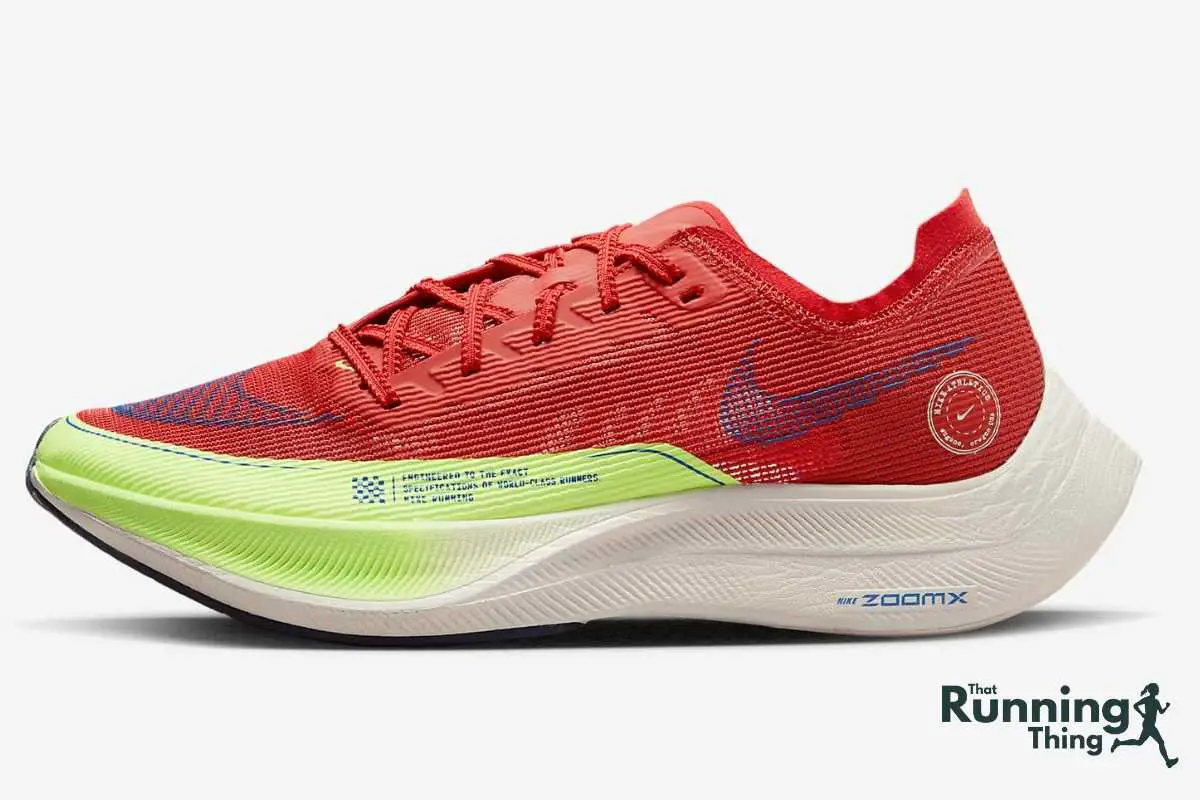You may have heard a jogging buddy talk about carbon plate running shoes and wondered if you should train in them. Especially as I became more passionate about running, I thought about using carbon plate shoes. After doing a bit of research on the topic and speaking with a couple of friends, this was what I learned. Should you train in carbon plate shoes?
Many runners rotate between carbon plate running shoes and regular running shoes to strengthen their foot muscles. You may train in them if you run the marathon in carbon plate shoes. While they improve the performance of elite runners, beginners may find them needlessly expensive.
If you’d like to learn more about carbon plate running shoes and whether you should train in them, keep reading. I will cover who it makes sense for and when to train in them.
Are Carbon Plate Running Shoes For Everyone?
The running community has hyped carbon plate running shoes due to them breaking world records. In the major marathons of 2019, the runners who wore Nike Vaporfly shoes grabbed 31 out of 36 podium positions. Most serious athletes choose them because they can’t compete without them.
Beginners new to running may see fewer benefits. For example, while carbon plate shoes will improve your performance, most coaches recommend that beginners improve their running form first. This refinement will improve speed and reduce the risk of injury.
Carbon plate running shoes make the biggest difference for long-distance runners who can already run fast. Slower runners won’t see as big of a difference.
Everyone differs and you might like them, but the faster-paced runners see the best return. Shoe manufacturers designed the aggressive rocker and stiffness for the faster running speeds.
Another reason that beginners may want to start with regular running shoes comes from the expensive cost and lower lifespan. Carbon plate running shoes (see this post for pros and cons) cost anywhere from $200 to $300. While they cost more than regular running shoes, they only last 155 to 186 miles. Compared to regular running shoes, they last anywhere from 300 to 500 miles, depending on the brand.
For beginners without the extra cash, they may dislike how fast they wear out. You’d find yourself having to buy new running shoes sooner and for a higher price.
Are Carbon Plate Running Shoes Legal?
Before you train in carbon plate shoes, check to see that the race or marathon you want to enter allows them, some prototypes are not allowed.
Carbon plate running shoes are allowed for the majority of running races as long as they are available for general retail purchase. Runners are advised to check the terms and conditions of the race to be sure.
World Athletics, for example, banned the Nike Vaporfly. They set a limit to theDue to the unfair advantage, number of internal carbon running plates and a maximum sole thickness. World Athletics, the governing body of running, hosts many marathons, which makes it worth paying attention to.
You don’t want to train in banned carbon plate shoes. Most experts recommend that you run a marathon in the same shoes that you train in since it will lead to consistent performance. Going from carbon plate to regular shoes in a marathon will mess up your performance time.
Still, most competitions continue to allow carbon plate shoes, and it may make sense for the most serious running athletes to get the best running times.
Are Carbon Running Shoes Worth It?
Carbon plate shoes unquestionably improve running performance, but you need to understand their limitations. Some believe that they reduce the risk of injury, but others think they increase your risk if worn too much.
Whatever camp you fall into, don’t cut corners on your daily physical therapy or stretching because the shoes still require common sense.
They won’t cure performance problems, but they can improve your performance to a degree. Nike estimates that the Vaporfly improves running performance by about four percent. You won’t see a huge difference except at the highest levels of training, but some may still prefer them.
Some may argue that the reputation of them being super shoes has a positive psychological effect on runners when they lace them up every so often.
Many runners treat carbon plate as spikes on shoes in that they weren’t meant to be used all the time. Instead, use them for your hard workout sessions and competitions.
Thinking Of Running An Ultramarathon?
Running experts define ultramarathons as races over the standard 26.2 miles. The most common marathon distances over this include 50k, 100k, 50 miles and 100 miles. Carbon plate running shoes reduce energy cost and fatigue when running. You can run harder for longer in carbon plate shoes.
Due to those advantages, many long-distance runners will use them to avoid fatigue. Carbon plate is no silver bullet, but it will make a difference in the slight advantages. When talking about the most elite running competitions, that small sliver can mean the difference between the gold medal and the silver.
How Carbon Plate Will Impact Training
The points where carbon plate will make a difference includes:
- Propels you forward faster
- Improve running performance
- Works well for long distances
- Ease of movement
For easier workouts, you might choose regular running shoes to preserve your carbon plate shoes. Some runners argue that running in carbon plate running shoes every day will decondition your calves and increase the risk of injury. To mitigate those issues, runners switch them out. They may run with them two to three days out of the week. This strategy keeps them fresh for competition.
Which Running Shoes Have A Carbon Plate?
There are numerous brands producing running shoes, but all of them currently produce running shoes with carbon plates in them.
The follow manufacturers lead the way in providing carbon-plated running shoes:
- Asics
- HOKA One One
- New Balance
- On Running
- Saucony
I highlight this information so that you’ll know where to look if you’d like to check out carbon plate shoes. They may not be for everyone, but many in the running community see them as super shoes.
See my article here for the differences between sneakers and running shoes for more information.
Should You Train With Carbon Plate Running Shoes?
You have a few areas where training in carbon plate shoes makes the most sense. Some examples of where you may want to train in them include:
- Interval running
- Long distances
- Tempo runs
Keep in mind that manufacturers designed each carbon plate running shoe for different purposes. Look for one that they designed for your specific running to see the most benefits.
You can use carbon plate shoes strategically. For example, because of the return of energy, you reduce fatigue and recover faster in them.
On days when you feel exhausted, you might switch out from your regular pair to carbon plate to reduce the impact while running. The extra cushion in the shoe plays a big role in the better recovery time.
What Are The Disadvantages Of Carbon Plate Shoes?
Disadvantages start with a higher cost, then there is a shorter life span. Runners must run quickly to take fuller advantage of the design features and there is an increased risk of injury.
Provided that you use them correctly, carbon plate shoes will make a positive difference on your runs. Overuse of them may lead to injury, but most believe that they reduce injury when used in rotation.
Keep in mind that no conclusive evidence exists in either direction. I would avoid overuse, however, because they’re more expensive and the general consensus in the running community is that overuse risks an injury.
What Does The Carbon Plate Do In Running Shoes?
The carbon plate provides a higher level of rigidity and therefore stability in the running shoe midsole. As a result of this rigidity there is a higher level of energy return, thus improving running performance.
Do Carbon Fibre Shoes Work?
Carbon fibre shoes have made an unquestionable difference in the running world where most runners see them as a type of super shoe because they have broken multiple world records. In marathons, many runners say they can’t compete without them since they have become pervasive.
Do Carbon Plated Shoes Help Slower Runners?
Slower-paced runners will see less of a return on investment since they designed carbon plate shoes especially for the faster runners. The stiffness and the aggressive rocker were designed to improve your running speed but it may not work as well for slower runners.
Should You Train Differently With Carbon Running Shoes?
Most runners don’t recommend that you run in carbon plate running shoes every day since it can make you more susceptible to injury over time. Instead, they recommend that you alternate your training in them and run in the shoes two to three times per week for the harder workouts.
Final Thoughts
Training in carbon plate running shoes makes the most sense when you rotate in between them and regular shoes. Doing this prevents them from wearing out early. They make the most sense for intense running training like interval training since you won’t fatigue as quickly, and you can run faster.
If you want carbon plate running shoes, I’d recommend the Nike Men’s Zoom Fly 4 Low Top and the Nike Women’s Low Top Trainers.


